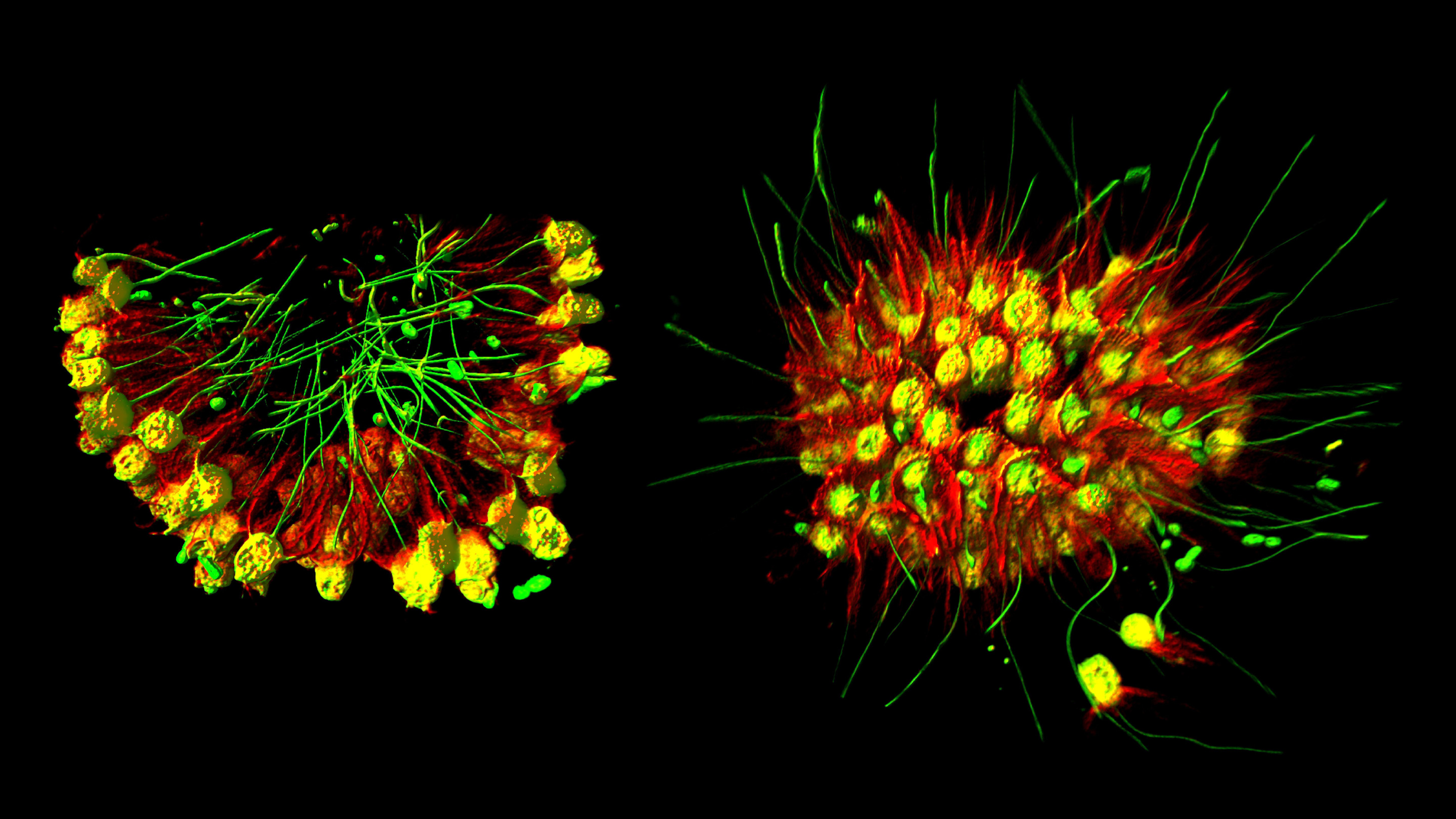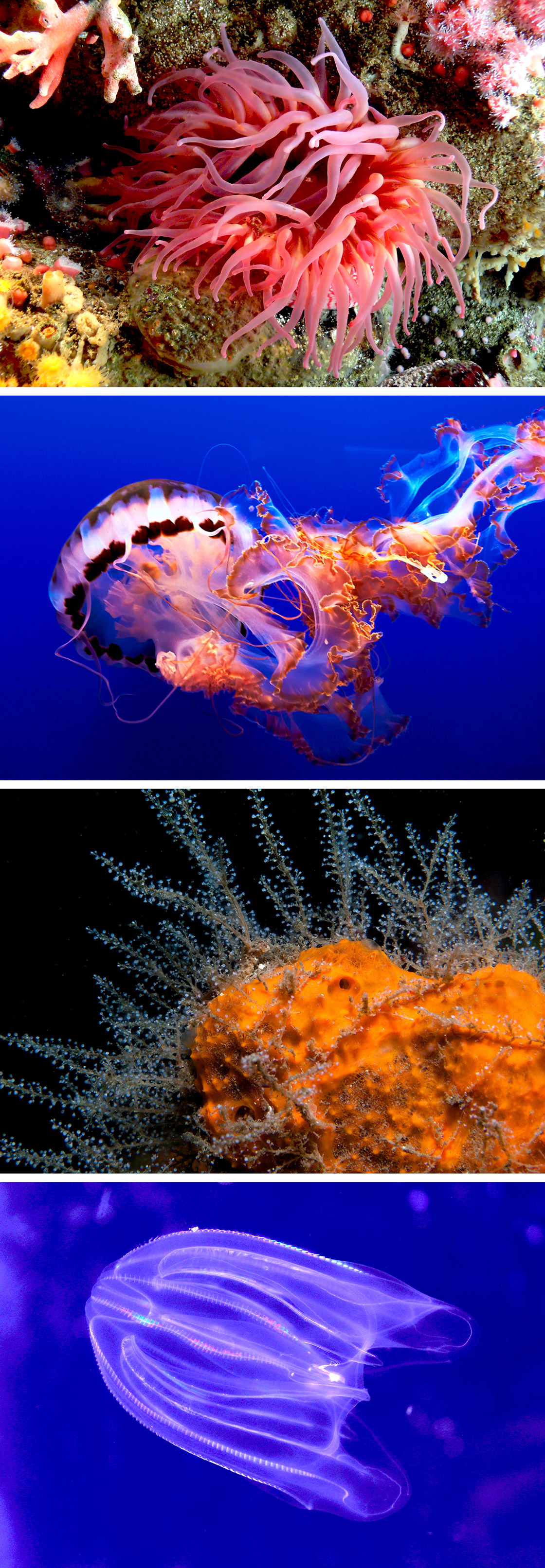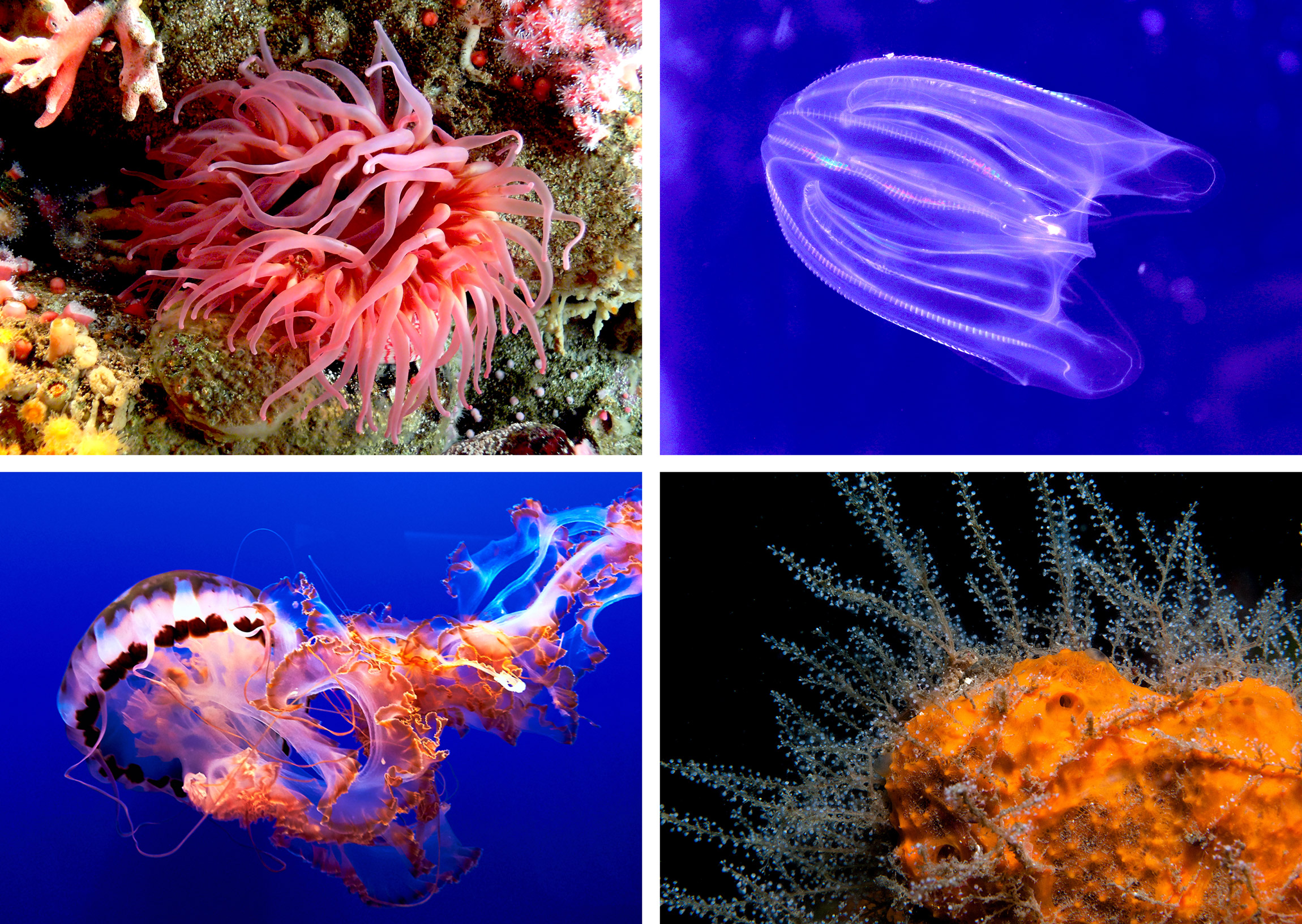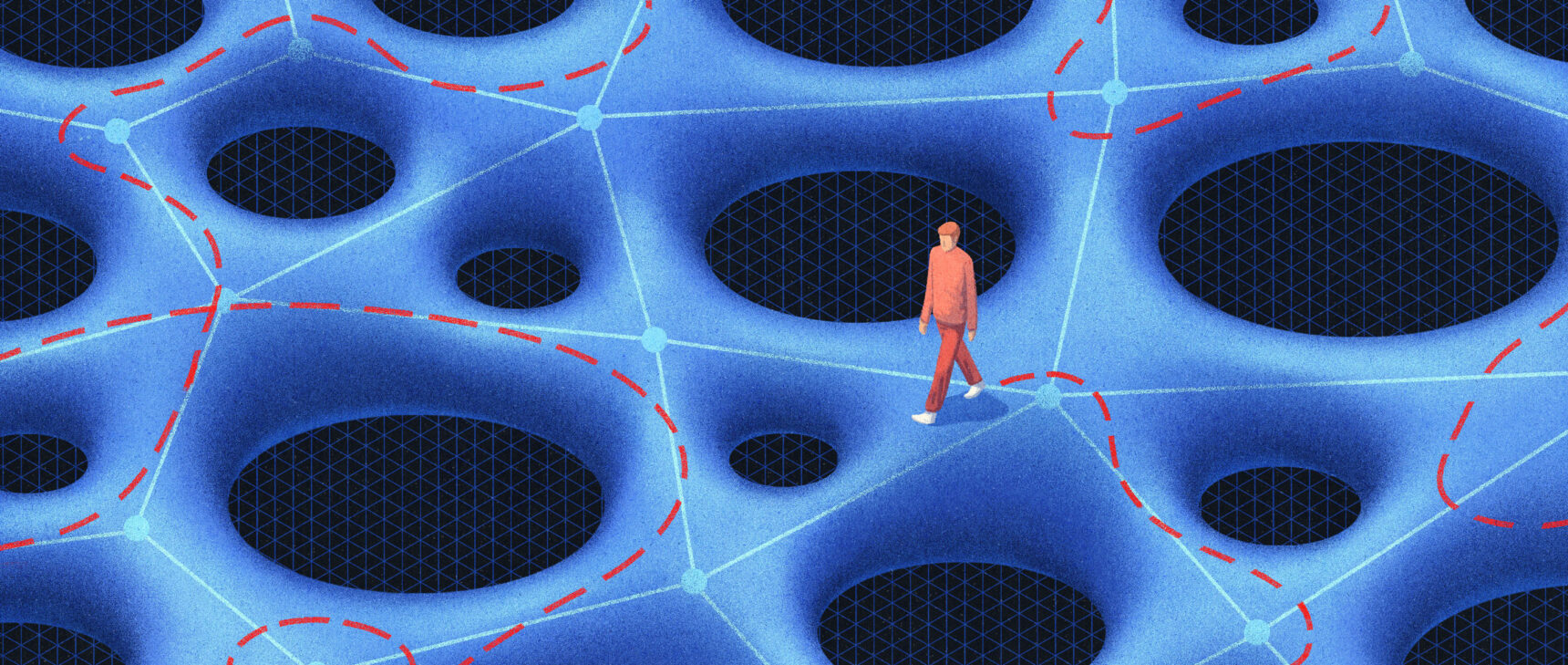Brain-Signal Proteins Evolved Before Animals Did

Choanoflagellates, the microbes gathering into arrays in these false-color images, are the single-celled organisms most closely related to the animal kingdom. New work shows that their ancestors made proteins that were later repurposed by the nervous systems of the first animals.
Thibaut Brunet
Introduction
Our human brains can seem like a crowning achievement of evolution, but the roots of that achievement run deep: The modern brain arose from hundreds of millions of years of incremental advances in complexity. Evolutionary biologists have traced that progress back through the branch of the animal family tree that includes all creatures with central nervous systems, the bilaterians, but it is clear that fundamental elements of the nervous system existed much earlier.
How much earlier has now been made dramatically clear by a recent discovery by a team of researchers at the University of Exeter in the United Kingdom. They found that the chemical precursors of two important neurotransmitters, or signaling molecules used in nervous systems, appear in all the major animal groups that preceded creatures with central nervous systems.
The big surprise, however, is that these molecules are also present in single-celled relatives of animals, called choanoflagellates. This finding shows that animal neuropeptides originated before the evolution of even the very first animals.
The discovery “solves a long-standing question about when and how animal neuropeptides evolved,” said Pawel Burkhardt, who studies the evolutionary origin of neurons at the Sars International Center for Marine Molecular Biology in Norway. It also indicates that at least some of the signaling molecules fundamental to the operation of our brains first evolved for an entirely different purpose in organisms that consisted of only a single cell.
Animal nervous systems are made of neurons that connect to each other, zipping information across synapses with a variety of small peptide neurotransmitters. These peptides are the language with which neurons speak to each other.
But when evolutionary biologists tried to deduce which animal cells first started to use that language, the murkiness of early animal evolution interfered. A variety of molecules very similar to neuropeptides are made by nearly all the early animal groups, including the ctenophores (comb jellies) and the cnidaria (jellyfish, corals and sea anemones). Even the extremely simple animals called placozoans, which have no cells resembling neurons, make neuropeptides. Sponges seemed to be the only exception, which is why it was generally thought that animal neuropeptides originated in cnidarians or ctenophores, after sponges branched away from the rest of the animal tree.
The problem with that theory, though, is that the amino acid sequences of the neuropeptides in the early animal groups are so different from bilaterian neuropeptides that none seemed similar enough to be ancestral to them. Worse, a wide variety of unrelated neuropeptides are also made by many single-celled animals, or protozoans. The evolutionary trail for brain neuropeptides seemed to vanish into a thicket.
This impasse was broken recently by Luis Yañez-Guerra, who studies evolutionary neurobiology in the lab of Gáspár Jékely at the University of Exeter. To trace the origin and evolution of various animal neuropeptides, Yañez-Guerra mapped neuropeptides onto the evolutionary tree of early-branching animals and their close relatives, the choanoflagellates.
From his doctoral work, he had already created a large list of animal neuropeptides, and as he began looking for them farther down the animal tree, he stumbled on the realization that choanoflagellates made protein precursors of two mature neuropeptides, phoenixin and nesfatin.
Their presence in choanoflagellates was a surprise because neuropeptides typically appear in the context of sender and receiver neurons. “In a unicellular organism, it’s more difficult to make sense of,” Yañez-Guerra said. “This shows that these neuronal molecules started evolving even before the need for this extensive communication between cell and cell. That’s why it was kind of shocking.”


Neuropeptides have now been found in all the major early branches of animal life, including (from top) cnidarians, such as sea anemones and jellyfish, the sponges and the ctenophores or comb jellies.
(from top) Bernard Spragg; Pedro Szekely; Klaus Stiefel; Maritime Museum at Norwalk
Neuropeptides have now been found in all the major early branches of animal life, including (clockwise from top right) the ctenophores or comb jellies, the sponges, and the cnidarians, such as jellyfish and sea anemones.
(clockwise from top right) Maritime Museum at Norwalk; Klaus Stiefel; Pedro Szekely; Bernard Spragg
The precursors of phoenixin and nesfatin are not used directly as neuropeptides by nervous systems; instead, these long peptides are chemical precursors that get chopped up and processed into smaller molecules that become the functional, mature neuropeptides. Their hidden identity may be why they were not identified as promising leads earlier.
A further search of the gene expression data confirmed Yañez-Guerra’s hunch that phoenixin and nesfatin might be the keys to understanding neuropeptide evolution. Not only were the precursor peptides present in the choanoflagellates, but they were also present in all the early animal groups — even the sponges, where they had been overlooked.
Given that the precursor molecules in the choanoflagellates are so directly connected to these neuropeptides found in all animals, Burkhardt explained, “The last common ancestor of all animals likely had at least two neuropeptides.”
The question that naturally arises is: What were those neuropeptide precursors doing in choanoflagellates, since it couldn’t have been neural signaling? There isn’t a definitive answer yet. Choanoflagellates do appear to produce the mature phoenixin neuropeptide, but not the mature nesfatin neuropeptide. It’s possible that choanoflagellates used their phoenixin neuropeptides to communicate with each other, for instance to coordinate the formation of choanoflagellate colonies.
But in their paper, Yañez-Guerra and his colleagues also suggest that the precursors may be multifunctional “moonlighting” molecules. They point out that, based on their peptide sequences, both precursors are likely to be secreted molecules. They also noted that while the phoenixin precursor can be processed to yield neuropeptides, a segment of it can also become a “chaperone” that ensures that proteins are folded correctly to form a critical complex of the energy-harvesting equipment of mitochondria.
During the evolution of the precursors, selection pressure for those “moonlighting” functions might have been a bigger factor than any need for intercellular signaling. Currently, Yañez-Guerra and Burkhardt are working together to study a mutant choanoflagellate that is missing the phoenixin precursor in an effort to better understand its function. They are also searching for receptor molecules in the choanoflagellates that would receive the neuropeptides.
Unfortunately, the fact that these two neuropeptide precursors are shared by all animals hardly simplifies the early evolution of nervous systems. Last December, Mariia Sachkova and her colleagues at the Sars Center, working with Burkhardt, reported that with the help of a machine learning tool, they had identified many peculiar neuropeptides encoded in ctenophore genomes, many of them unlike any others in the animal kingdom.
The neuropeptides aren’t the only thing that’s unique about ctenophore nervous systems: The structures of their neural networks are so unusual that researchers suspect they evolved independently of those seen in humans and other animals. Why ctenophores do things differently is a mystery, but it’s clear that nervous systems went through a period of tremendous experimentation and innovation early in their evolution — and that at least some of that experimentation began before animals even existed.
Correction: June 13, 2022
The microbe originally pictured in the opening image was misidentified as a choanoflagellate. It has been replaced with actual images of groups of choanoflagellates.



